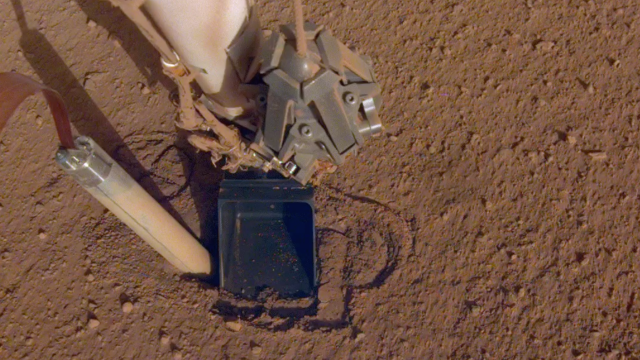After some hopeful digging, Mars seems to have spat out the InSight heat flow-measuring probe.
When InSight landed on Mars, it had two seemingly simple tasks: use its robotic arm to place its seismometer on the surface, and deploy its heat probe mole instrument to dig 10 to 16 feet underground. The latter has proven far more difficult than was initially expected.
NASA on early Monday morning tweeted the news and a timelapse showing the planet ejecting the probe:
Mars continues to surprise us. While digging this weekend the mole backed about halfway out of the ground. Preliminary assessment points to unexpected soil properties as the main reason. Team looking at next steps. #SaveTheMole #Teamwork pic.twitter.com/UURvU8VTwZ
— NASA InSight (@NASAInSight) October 27, 2019
Heat-probe drama has marred the mission since NASA’s InSight lander plopped down onto the Red Planet last November. InSight’s scientists were hoping to find a region free from boulders with loose, sandy soil to plant the Heat Flow and Physical Properties Package (HP3), and seemingly found one. They deployed the device, where, using a self-powered hammer, it was supposed to push itself deeper and deeper into the soil. In the first few days of hammering, it dug at most a foot and a half down before meeting dense, cement-like soil that stopped its progress.
NASA’s researchers worked for months to try to figure out a way to get the probe to keep digging through the thick “duricrust.” Their initial solution was to press the soil down around the probe with the rover’s mechanical arm in order to increase the pressure as well as the friction around the probe.
The technique seemed to work, and the probe descended another inch. Until yesterday, when it popped right back out. The InSight team is once again working to try and understand the situation. They tweeted: “One possibility observed in testing on Earth is that soil could fall in front of the mole’s tip as it rebounds, gradually filling the hole in front of it as the mole backs out.”
These drawbacks have obviously been frustrating. The HP3 is one of three main experiments on the lander, alongside the “Marsquake”-detecting Seismic Experiment for Interior Structure and the magnetic field-measuring Rotation and Interior Structure Experiment, or RISE. Together, these instruments are supposed to measure how geologically active the planet is, and they have already begun delivering exciting results. The heat probe’s potential failure wouldn’t negate the other instruments’ science, but it would be a frustrating loss.
We’ve reached out to experts on the matter and will update the post when we hear back. But for now, we’re just crossing our fingers and hoping a fix comes soon.
